Want to see an updated, corrected, and generally better version of this article? Check it out at its new home on Suburban Pagans.
If you wanted to live in the Philippines, it would help if you really, really liked Jesus. A lot. With a Catholic majority of at least 85%, the nation is the third largest predominately Catholic country on Earth, and the largest in Asia (with East Timor being its lone competition). And, for the most part, we’re not talking about fair weather Catholics, either — say, the types who only make it to mass on Christmas and slack off for the rest of the year — but instead Catholics of an especially devout nature. Did I mention that their Christmas season lasts longer than that of any other country on Earth? That‘s a lot of masses.
Given that the Catholic faith plays such a big part in the everyday lives of so many Filipinos, it’s not too surprising that its influence also permeates the P.I.’s popular culture. This is true not just of specifically religious themed entertainments, but of pretty much everything. Because of this, it’s not uncommon for Pinoy films of any genre — horror, action, what have you — to take sudden detours into religious territory without warning. So consider yourself fairly warned if you’re someone like me who finds Christianity just a little bit creepy.


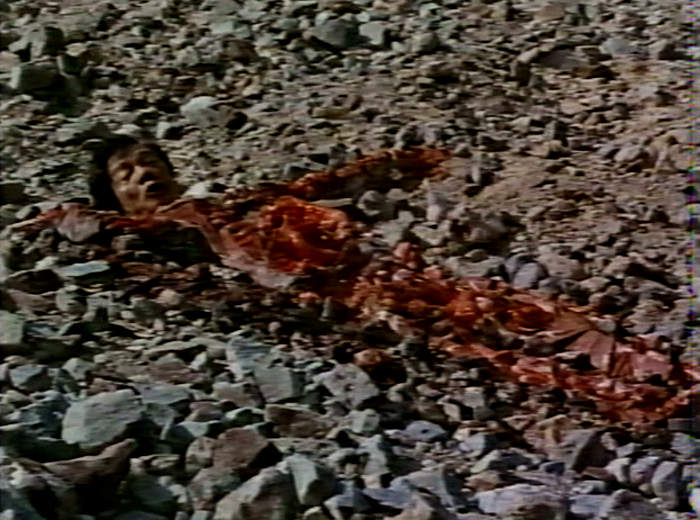
In light of all of the above, it probably won’t surprise you when I tell you that a Filipino film called The Killing of Satan comes freighted with some pretty strong Catholic overtones. But, more interestingly, the film also serves to highlight one of the more unique aspects of the Filipinos’ practice of the faith. You see, back in the 16th century, when the Spanish first came to the islands with the intention of converting the populace, they did their best to rid the Filipinos of what they considered to be their evil, pagan ways. (The Muslims, at least that majority of them who lived in the rugged Mindanao region, weren’t having any of it, and sent the Spaniards packing.)
It seems, however, that the Spanish ultimately decided that a Catholic majority Philippines in which some inhabitants still retained aspects of their previous atavistic beliefs was preferable to none at all. So Catholicism flourished in the Philippines, but it was a Catholicism that also incorporated within it some of the islanders’ older beliefs about spirits, mysticism and magic. And that’s where The Killing of Satan comes in.
OK, a serious historian might disagree that that is precisely where The Killing of Satan comes in. I’m sure other important stuff happened in the Philippines between the time in the 1500s when the Spanish converted the majority of the population to Christianity and 1983, when The Killing of Satan was made. But, for my limited purposes, that’s where it comes in. This isn’t Wikipedia, after all.



Like any epic fantasy worth the stock it’s filmed on (at least those made since 1977), The Killing of Satan centers around the idea of a Chosen One, one of those reluctant heroes with hidden powers that reveal themselves only once destiny calls. Here that chosen one is Lando, played by Ramon Revilla. Revilla was a popular star going back as far as the 1950s, whose macho image fueled rumors that he had fathered upwards of several dozen illegitimate children. He would later parlay his popularity into a career in politics, and would be elected to the Filipino senate in 1992. I haven’t seen any of Revilla’s other movies, but I’m guessing that none of them were too similar to The Killing of Satan, because he spends a lot of the movie looking like he’s kind of surprised to be in it. Then again, I don’t think that there are any movies similar to The Killing of Satan, so that’s pretty understandable.
Anyway, before we can meet Lando, The Killing of Satan sets the tone by showing us a reenactment of the crucifixion in which a trio of men bearing crosses on their back are followed up a hillside trail by a phalanx of penitents bloodily whipping themselves — a sight that is not uncommon in parts of the Philippines during Holy Week. As this goes on, a group of villagers are elsewhere having a secret meeting in a space adorned with various Christian icons and candles arranged in the shape of a cross. They appear to be some kind of magical cabal. Their huddle is soon intruded upon by a red-garbed figure known as the King of Magic (Paquito Diaz), who comes with a retinue of black clad minions who enjoy cackling evilly just as much as he does. (And who, despite his appearance, we will later be surprised to learn isn’t the Big Guy referred to in the title.) A battle ensues, which mostly consists of the parties throwing magical spells at each other, with that occasionally being represented by cartoon laser beams shooting out of people’s hands.



Now, those of you who have read more than a few of my reviews have probably already been alerted to the fact that I love movies that feature scenes of people shooting cartoon laser beams out of their hands. It’s not just that such scenes contain within them such a perfect balance of stupidity and awesomeness, but also that they are generally the moment at which a film that is already basically just a live action cartoon is at its most nakedly honest. Usually I depend on the Taiwanese for such content, but I have to say that The Killing of Satan might just be more rich with scenes of animated, palm-projected mayhem than any other film that I’ve seen. Seriously, once the movie’s conflict has been established, there is barely a moment during which people aren’t just “pew pew pew”-ing away at each other all over the place. But I digress.
The fight takes a turn against the villagers when the King of Magic uses a move against their elderly leader, Miguel, that causes his head to spin around on his body Linda Blair style. Such maneuvers take a toll even on the body of one who is magically empowered, it seems, and so we soon find ourselves cutting to Miguel on his deathbed. His brother Renzo (George Estregan) asks him to name his successor as leader of the group, and though Renzo might be thinking to himself “Renzo, Renzo, Renzo”, Miguel sticks a pin in it by instead naming his nephew Lando San Miguel as the man for the job. Presumably because no one in the village owns a telephone — which, from the looks of things, is pretty plausible — the group then begins a program of steady chanting that will carry on through the first half hour of the movie until Lando finally makes his appearance at their doorstep, and then it’s probably only by coincidence.
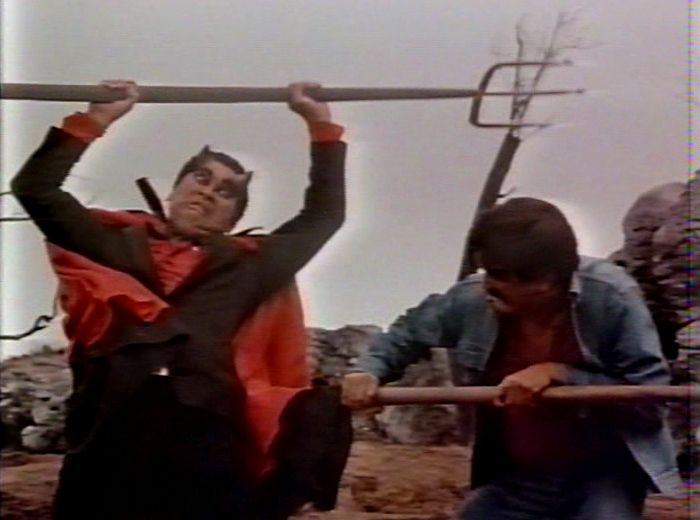


Because, you see, back in his own little village, Lando seems to have plenty of troubles of his own. Recently released from prison, Lando explicates his own particular brand of faith when he tells his wife, “I pray to God that nothing will happen to make me kill again.” Last time around, he killed the brother of a local crumbum named Ibanez — an act, he says, that was done in defense of the innocent people of the village — and Ibanez, now given word of Lando’s release, is broadcasting his desire for payback. Meanwhile, the chants of Renzo and his group in their faraway village succeed only in making Lando have a weird nightmare in which he sees his Uncle Miguel get run over by a giant boulder. This leaves Miguel’s body and extremities flattened to a thin, pulpy paste, yet he remains able to speak. It looks like something out of a Roadrunner cartoon, except gross, and is just the first of a number of jaw dropping gore effects to be found in The Killing of Satan, some of which rely on the kind of flimsy tearaway prosthetics that bring back happy memories of The Story of Ricky.



Inexorably, the day comes when Ibanez finally tracks Lando down, and in the ensuing shootout Lando is shot in the head and dies. At the exact same moment, Uncle Miguel starts up in his sickbed with an identical head wound and also dies, which reminds me that the ability to die from other people’s wounds would be just about the last magical power I’d ever want. In any case, the effect that this has is that Lando doesn’t die after all, and later revives in his bed much to the surprise of pretty much everyone. Soon afterward, Lando, his wife Luisa (Cecille Castillo) and their daughter Betty set off in their outrigger canoe for a visit to Uncle Miguel’s seaside village. Just like the villains in a James Bond movie, who seem preternaturally aware of the threat posed by the hero before he’s even had a chance to do anything, the unseen enemies of Godliness make the first of many attempts to block Lando’s progress by throwing a freak windstorm at him, which he survives only to be greeted by a freak rock slide when he arrives.
With Miguel dead, it falls to Renzo to walk Lando through the familiar particulars of being a Chosen One, and to deal with all the incredulity and protestations that we’ve come to expect Chosen Ones to initially express under such circumstances. (If no one’s drawn up a list of the clinical stages of dealing with being informed that you have a magical destiny, it’s pretty similar to grief, in that it always starts with denial.) Lando is “The Coronado”, or “The Proud One”, Renzo tells him, and has a calling to fight the “followers of evil”. To back up his point, Renzo calls upon none other than the late Uncle Miguel himself, who quite persuasively rises from the waves as a rotting corpse to deliver his encouragement. Finally, Renzo gives Lando a sacred phrase, “Sanctus Sancti Christum”, that will activate his magical powers, which, not surprisingly, turn out to mostly involve him shooting cartoon laser beams out of his hands, as well as a swirly hypno-wheel type thingy that makes him impervious to bullets.
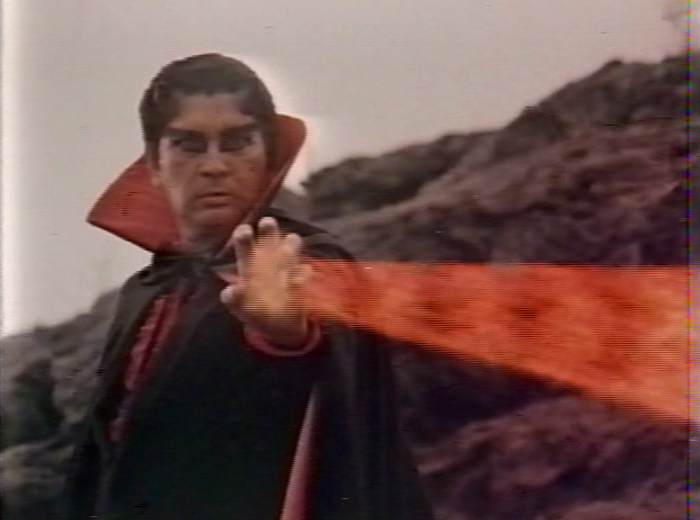
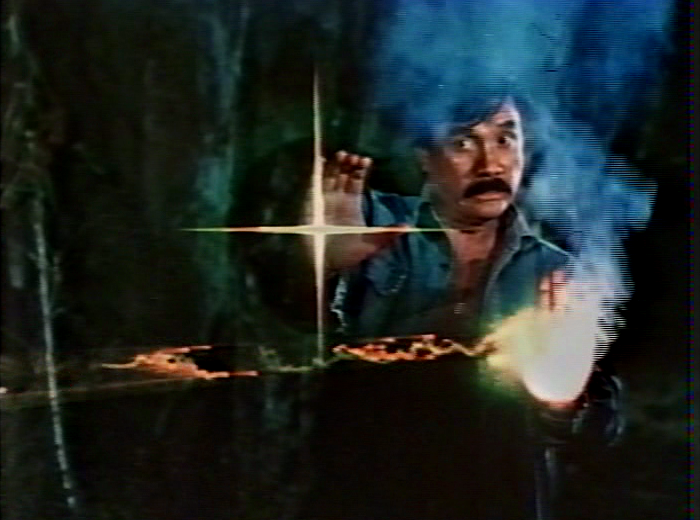

Despite this supernatural arsenal, I must point out that Lando is still a brawler at heart — and, more importantly, an exemplar of Filipino masculinity. (They don’t hand out those mustaches to just anyone, after all.) Throughout the film, he as such proves himself not content with simply vaporizing an opponent with his God rays. He always has to get his hands dirty, too, and enthusiastically hands out knuckle sandwiches and choke holds on even those occasions when simply frying his foe with a little hand magic might have been better advised.
In any case, it turns out that Lando’s supernatural endowment could not have come at a more fortuitous moment, because it is mere moments before the Prince of Magic’s men return to the village, put cartoon whammies on a bunch of people, and make off with both Lando’s daughter Betty and Miguels’ daughter Louisa. This affords Lando the opportunity to “pew pew pew” his way through a little target practice, though ultimately he and Renzo prove to have come upon the scene too late to be much help. They then set off on a manhunt that involves them doing a lot of aimless trudging around the same nondescript rock quarry in which a majority of The Killing of Satan’s action takes place. Meanwhile, back in the evil ones’ cavernous underground lair (which is mainly cavernous for the fact that it appears to be in a real cavern), Betty is thrown into a cage, while Louisa is left lying unconscious on a table where she can be freely groped by the Prince of Magic’s henchmen.
Along with Betty in the cage are about a dozen depressed looking naked women whose collective function seems to be to increase the amount of full frontal nudity in The Killing of Satan by about five thousand percent. The Prince of Magic tells Betty that she has been chosen to be his Master’s “bride”. And just in case these last couple paragraphs haven’t contained enough “ick” for you, let me point out that Betty looks to be about twelve. Of course, by this time we have a pretty good idea of who the Prince of Magic’s “master” is (Psst. It’s in the title.) and it’s easy to imagine that party responding to charges of being a pedo by simply saying, “Oh, well. I guess I’ll go to Hell then.”

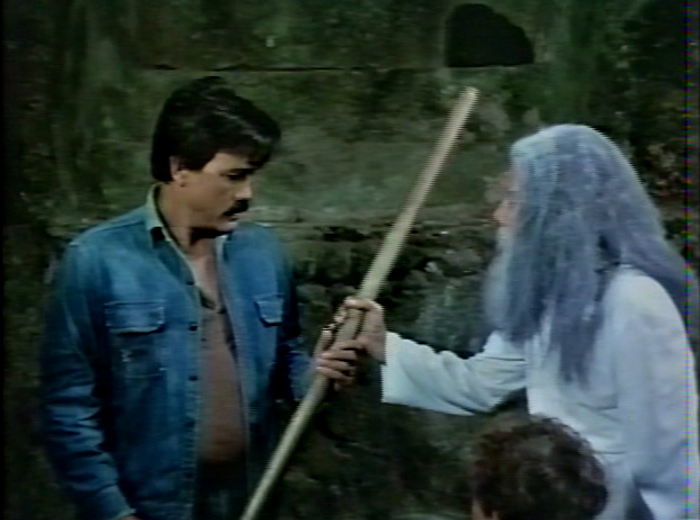

Interestingly, after a good deal of what seems like random quarry hopping, Renzo reveals that he has known exactly where the Prince of Magic’s lair was all along, first pointing out the entrance, then informing Lando that it is too dangerous and instead leading him to an alternate entryway. Once they enter, The Killing of Satan really gets down to business, by which I mean that Lando and Renzo are immediately pelted with all kind of snakes that are leaping/being thrown at them from all directions. This gives Ramon Revilla the chance to earn his own little piece of action hero immortality by picking up one snake and pimp slapping it. Renzo wisely concludes, upon seeing this, that he’s not going to get to do anything cool unless he goes off on his own, and so splits off on a separate path. Lando then encounters a snake that turns into a weird, sexless little snake boy, whom he easily strangles, and then some shirtless Bruce Lee guys whom he also makes short work of.
Lando eventually fights his way to Betty’s cage of nudity, and is informed by his daughter of her impeding marriage to the Prince of Magic’s boss. Unfortunately, Lando is unable to touch the cage due to a spell that can be lifted by the Prince of Magic alone, and so goes back out to the rock quarry to shout at the sky until the Prince of Magic shows up. The Prince then kicks his ass and has his men toss Lando’s unconscious body off a waterfall into the river below.
It says a lot about The Killing of Satan that I am loathe to single out any one of its sequences as being the strangest. Suffice it to say, then, that what follows is certainly among its more memorable. Lando floats down river and is pulled from the water by a strange mute boy, who takes him to the ruin of an old church that is inhabited by an old man in white robes who sports long gray hair and a generous beard. The man presents Lando with a cane, saying, “This cane has been waiting for you”, and then goes on to say that the cane should serve as his “principle weapon”. Personally, I would call it more of a staff than a cane, by the looks of it, but that may just be because my conception of the whole Chosen One idea is too narrow. It just seems like one would rather have a “Staff of Destiny” than a “Cane of Destiny”. Otherwise, you’re opening the way to — what? — the Crutch of Destiny? The Mobility Scooter of Destiny?
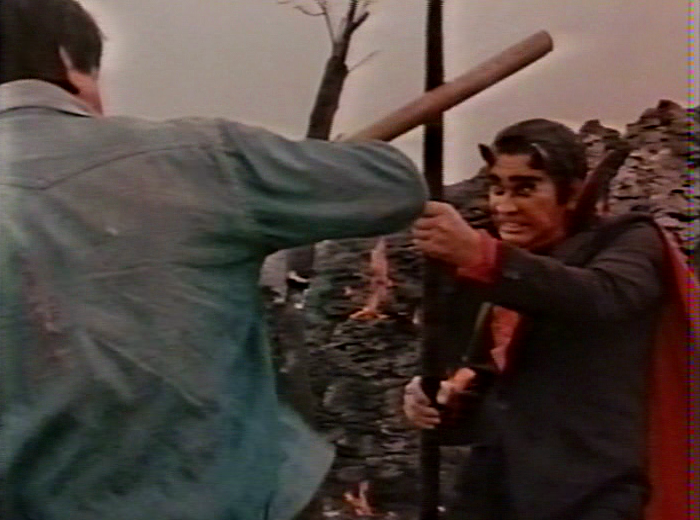


Anyway, Lando fills the old man in on the fact that his tween daughter is about to get married, and asks the man if he has any idea whom the mysterious groom might be. “Satan!”, beardy replies. And I think there was a thunderclap at that point, though it may just have been an implied thunderclap that I heard inside my head. Cane in hand, Lando then heads off, but not before asking the old man his name. “Those who love me”, the old man replies. “Call me their father.” Holy s… Never mind.
Lando returns to Satan’s cave to find that — what do you know? — his new cane shoots cartoon laser beams. Pew pew! Pew pew pew! Minions fall left and right, and then, eventually, the Prince of Magic himself. Finally Lando makes his way to the boss man, and if you thought for some reason that The Killing of Satan was going to take a more metaphorical approach to its depiction of Satan, then you really haven’t been paying attention to The Killing of Satan. Really, given what we’ve seen so far, how could Old Scratch here be anything other than a skinny, van dyke sporting dude in a red body stocking with horns and a pitchfork? Of course, when time for his nuptials arrives, he does slip into a tuxedo with a red lined, pointy collared cape, not to mention the fact that he also turns into a completely different actor, the more beefy veteran Pinoy star Charlie Davao.
And if you further thought that The Killing of Satan was going to take a more metaphorical approach to the actual killing of Satan, well… what the hell is wrong with you, anyway? In the event, Lando goes so far as to actually call Satan out, stomping around that quarry and yelling about how Satan’s “yellow” and doesn’t have the guts to go mano a mano with him. Satan does have the guts, of course, and appears before Lando in a wall of flame, after which we indeed do get to see Lando and Satan swinging at each other like a pair of drunken stevedores. Naturally, however, when it comes time to put paid to the deal, the two of them warm up their palms and get to zapping each other. Pew pew! Pew pew pew!
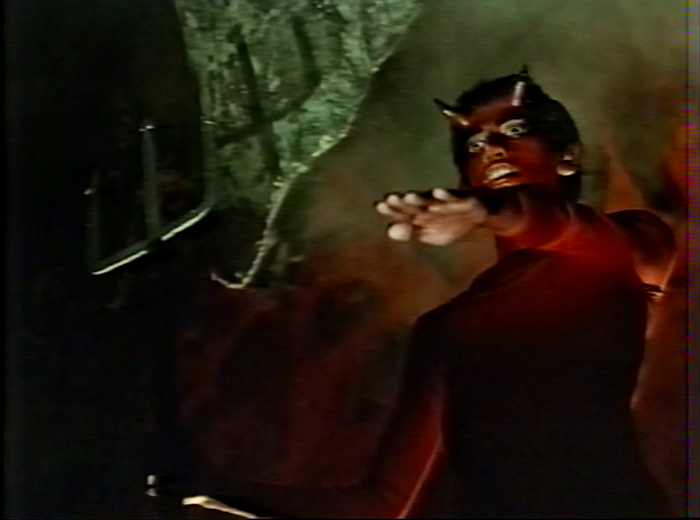


The Killing of Satan is a confusing film for the non-Filipino viewer, specifically in terms of what kind of film exactly it’s trying to be. I think that most people would think that a movie with so much overtly religious content would be evangelical in nature, yet The Killing of Satan simply uses that content as something upon which to hang an impressive array of unapologetically sleazy exploitation elements. It’s director, Efren C. Pinon, is no Ron Ormond, but rather a career genre man who’s helmed everything from entries in the Tony Falcon spy series to softcore “Bomba” films. And while it’s true that other exploitation films have made use of Christian lore and iconography, those films have generally sought to titillate by flirting with blasphemy. By contrast, The Killing of Satan never strays from a position of absolute piety, although it’s version of piety admittedly also involves lots of explicit nudity and graphic gore. In short, it’s that rare film that walks the high wire between having something for everyone and something for absolutely no one at all, and for that it deserves to be held in no small amount of awe, if not admiration.
Given its title, I don’t think it’s much of a spoiler to reveal that, at the end of The Killing of Satan, Lando does indeed appear to kill Satan. This presumably means that he has vanquished evil from the Earth, which, if you’re a Catholic, I think means that people don’t even swear of masturbate anymore. Still, The Killing of Satan refuses to dwell on the ramifications of the act, instead going for the old Shaw Brothers freeze frame soon after the battle’s conclusion. Has Lando given Beelzebub the death punch once and for all? Or will The Beast return to again walk the Earth? Either way, with a guy like Lando around, we’re always just a “pew pew pew!” away from salvation.
Release Year: 1983 | Country: Philippines | Starring: Ramon Revilla, Cecille Castillo, Charlie Davao, Paquito Diaz, George Estregan, Elizabeth Oropesa | Writer: Joe Mari Avellana | Director: Efren C. Pinon | Cinematographer: Ricardo Herrera | Music: Ernani Cuenco | Producer: Pio Lee
